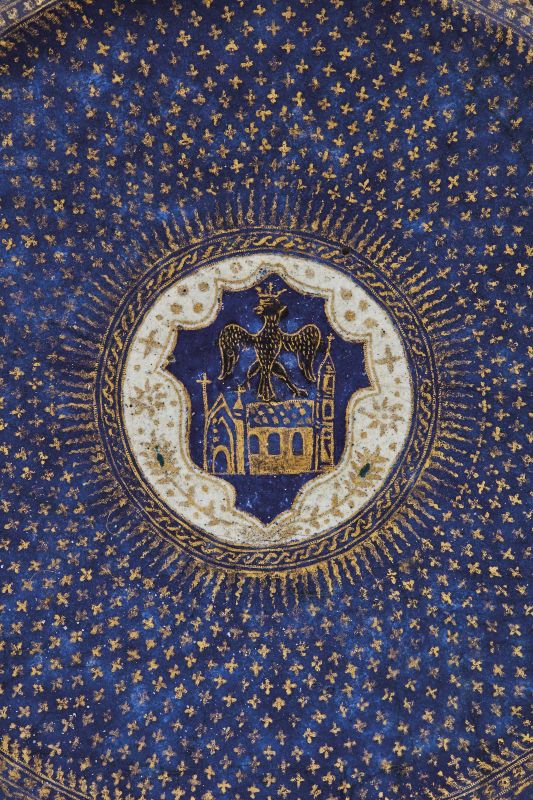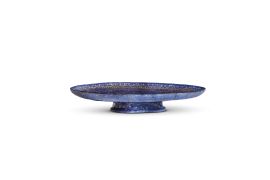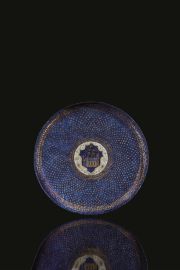FOOTED PLATE, VENICE, CA. 1500
copper, enamelled in blue, white and green, with gilt decoration, circular, coat of arms at centre; plate diam. 25.2 cm, foot diam. 10.4 cm, height 4.2 cm
Provenance
Collection J. Kugel, Paris
Collection Yves Saint Laurent et Pierre Bergé, Paris
Christie’s sale: Paris, 25 February 2009, lot 609
Private collection, Lombardia
Literature
F. Barbe, L. Caselli, M-E. Dantan (eds.), I rami smaltati detti veneziani del Rinascimento italiano. II. Corpus delle opere nelle collezioni pubbliche e private. Milan 2018, p. 130, no. 136.
This enamel-on-copper footed plate is circular, prevalently blue in colour and decorated on all surfaces with a number of different concentric gilded motifs encircling a coat of arms inserted in a medallion enamelled in white with two tiny touches of green; according to the classification proposed by Béatrice Beillard[1] and from the outer edge toward the centre, these ornamental motifs are: garlands, surmounted by fleurs-de-lis and centred on dots; five-petalled rosettes; oak leaves; fleurs-de-lis; undulating rays; twisted ribbons. At the centre, enclosed in a white enamelled tondo decorated with gilded plant motifs, crosses and dots, a horsehead shield encloses a gold and black emblem on a blue ground. The reverse side of the plate is also entirely enamelled in cobalt blue with five-pointed gilt rosettes arranged in concentric bands, except in the area at the centre of the foot, where the copper is visible beneath a thin layer of transparent glaze, also decorated with small gilded rosettes.
Attribution of this precious object to Venetian manufacture, while conventionally accepted by the academic world, nevertheless leaves room for some uncertainty: there is as yet no definite proof that the Venice area was the actual production location for an important group of works, enamelled coppers dating to a fifty-year period around the year 1500. This group, distinguished by common characteristics, is essentially made up of objects for everyday use such as vases, dishes, footed plates, salt cellars, pitchers, candlesticks and pax-bredes, all crafted of copper as supports for richly-coloured enamel and gilt decoration – and all displaying motifs which are similar in form to coeval works in precious metals, gold and silver. And while the Cini Collection of Venice is home to an important nucleus of these works, of which we reproduce one of the most outstanding pieces (see fig. 1), their inclusion in major Italian and foreign museum collections and in private collections worldwide provides further testimony to their importance. That interest in these so-called Venetian enamel-on-copper works arose in the mid-19th century was explained by Louis Courajod in an article published in 1885 and by Émile Molinier in his studies of the Venetian decorative arts, published in 1889, and was confirmed by Lionello Venturi in the 1920s. An interesting synthesis of writings on the subject emerged from the international conference held at the Isola di San Giorgio in Venice in 2014; it was followed in 2018 by publication of the conference proceedings (Atti) and the Corpus,[2] which sets forth the results of an attentive review of 334 enamel-on-copper objects, all ascribable to a single homogeneous group on the basis of era, characteristics and manufacturing technique and presents a detailed iconographic apparatus.
Review of the texts which have addressed the subject of enamel-on-copper works over the span of a century and a half confirms that attribution to Venice of this particular category of objects has always been based on the analogy between the technical manufacturing processes involved in enamelling on copper and enamelling on glass – the latter having been a prerogative of Murano from midway through the 15th century until the third decade of the 16th – and on vague resemblances between tableware belonging to the two categories. And if it has been proved that enamels suitable for use on metals were produced in Murano, it is still unknown where the embossed copper items were manufactured and where the enamel decoration was applied. According to Rosa Barovier Mentasti and Cristina Tonini,[3] attribution of these products to Venice and the involvement of Murano’s glassmakers in their manufacture would be supported by a meaningful coincidence between the forms of copper pieces and Venetian blown glass items dating to the late 15th century and the first half of the 16th, but careful analysis does not seem reveal a close formal affinity between the two categories of products.
Accepting attribution to the Venice area, another interesting consideration arises with regard to the coat of arms in the centre well of the footed plate. If in ceramics the function of inclusion of heraldic devices is to attest and communicate ownership (but also, often, is purely decorative), in the so-called Venetian enamel-on-copper works – much more costly and rarer, in light of the particular manufacturing techniques involved in their creation (very similar to those of the goldsmith) – the coats of arms are above all signs of distinction and social standing. Scholar Luciano Borrelli[4] has pointed out that of the 334 copper items catalogued in the Corpus, fifty-nine bear heraldic emblems: quite a high percentage. The fact that almost all of these are painted on formal tableware and chargers confirms that they were created for ostentatious show. Another function of the heraldic design was simple ornamentation of the surfaces and the objects to which it was applied; the outcome depended on the skill and aesthetic sense of the decorator, who was nevertheless at times forced to substitute certain colours with other non-original hues because he had exhausted his supply or because a particular pigment was unavailable in his era. In the case of the enamel-on-copper works we note a prevalence of blue and white, colours presumably also used to render coats of arms originally in different colours, and finishing touches in gold. Consequently, identification of a given coat of arms, difficult in the best of circumstances, becomes impossible or at the very least uncertain and admitting of more than one hypothesis if the device is not clearly characterised by heraldic charges. The study conducted by Luciano Borrelli[5] on occasion of publication of the plate in the above-cited Corpus resulted in tentative identification of the heraldic motif as a device of the Dalla Chiesa family of Modena[6] (see fig. 2). It is interesting to note that the device is analogous to the one found on three other plates published in the Corpus (nos. 132, 135, 137), but while two of these are differentiated by decorative treatment over the entire surface, the plate in the Kremlin Museums (inv. M3-2004) would seem to be, to all effects, the sibling of the plate presented here, exception made for the colour of the eagle, which is painted in black on the Russian plate (see fig. 3).
[1] B. Beillard, ‘Le décor à la feuille d’or des cuivres émaillés dits vénitiens: premier classement’ in F. Barbe, L. Caselli, M-E. Dantan (eds.), I rami smaltati detti veneziani del Rinascimento italiano, Vol. II, Milan 2018, pp. 9-21.
[2] F. Barbe, L. Caselli, M-E. Dantan (eds.), I rami smaltati detti veneziani del Rinascimento italiano. I. Atti del convegno internazionale di studi – II. Corpus delle opere nelle collezioni pubbliche e private. Milan 2018.
[3] R. Barovier Mentasti, C. Tonini, ‘Tra rami smaltati, maioliche e vetri. Firenze o Venezia?’ in F. Barbe, L. Caselli, M-E. Dantan (eds.), I rami smaltati . . ., Vol. I, p. 23-49.
[4] L. Borrelli, ‘L’araldica nei rami smaltati detti veneziani del Rinascimento italiano’ in F. Barbe, L. Caselli, M-E. Dantan (eds.), I rami smaltati . . . , Vol. II, p. 23.
[5] L. Borrelli, ibid., p. 33 no. 136.
[6] D’azzurro, alla chiesa di rosso, la facciata orientata a destra, fondata su una terrazza di verde; al capo d’oro, caricato di un’aquila di nero (Blue, the church in red, the facade facing right, founded on a green terrace; at the head, gold, surmounted by a black eagle)










